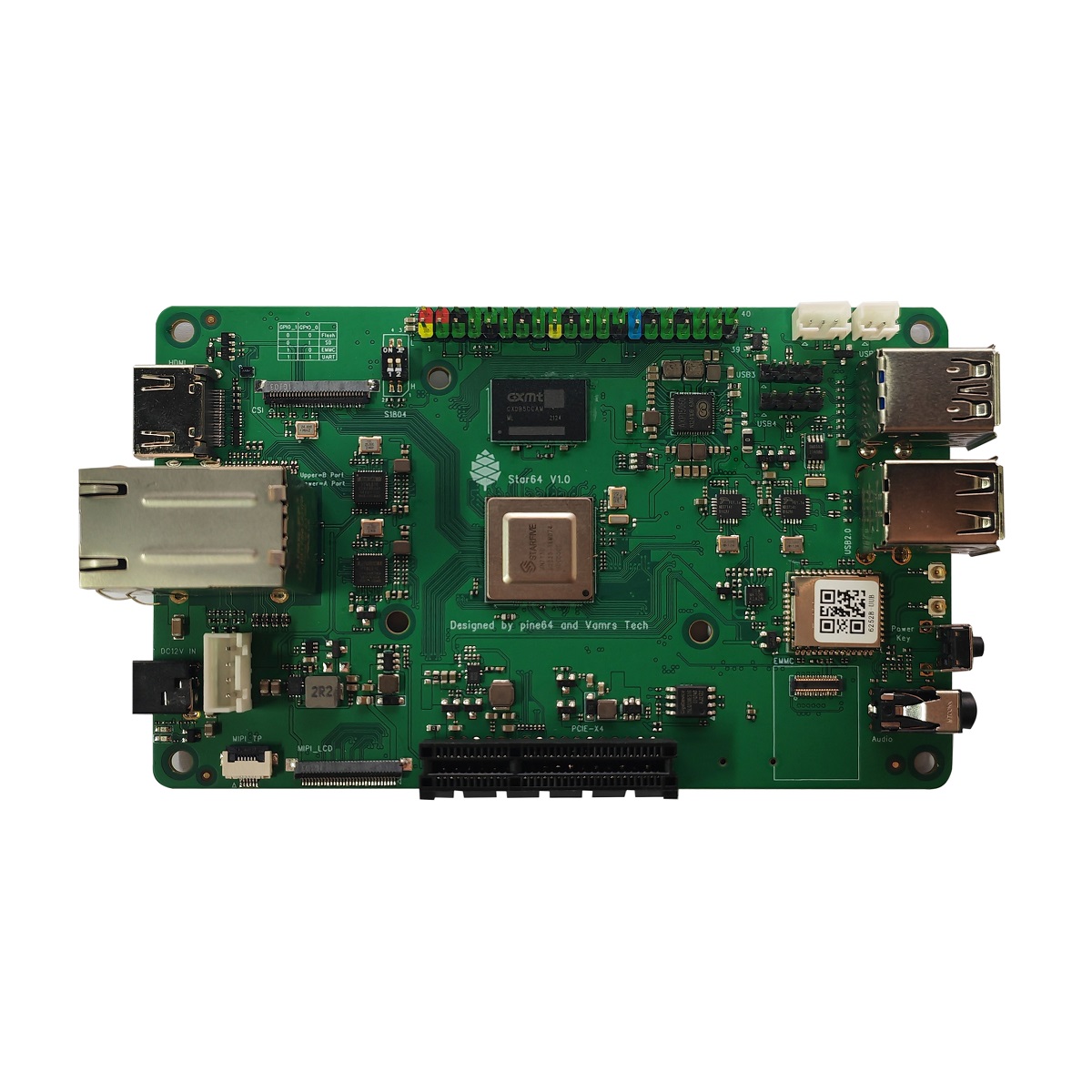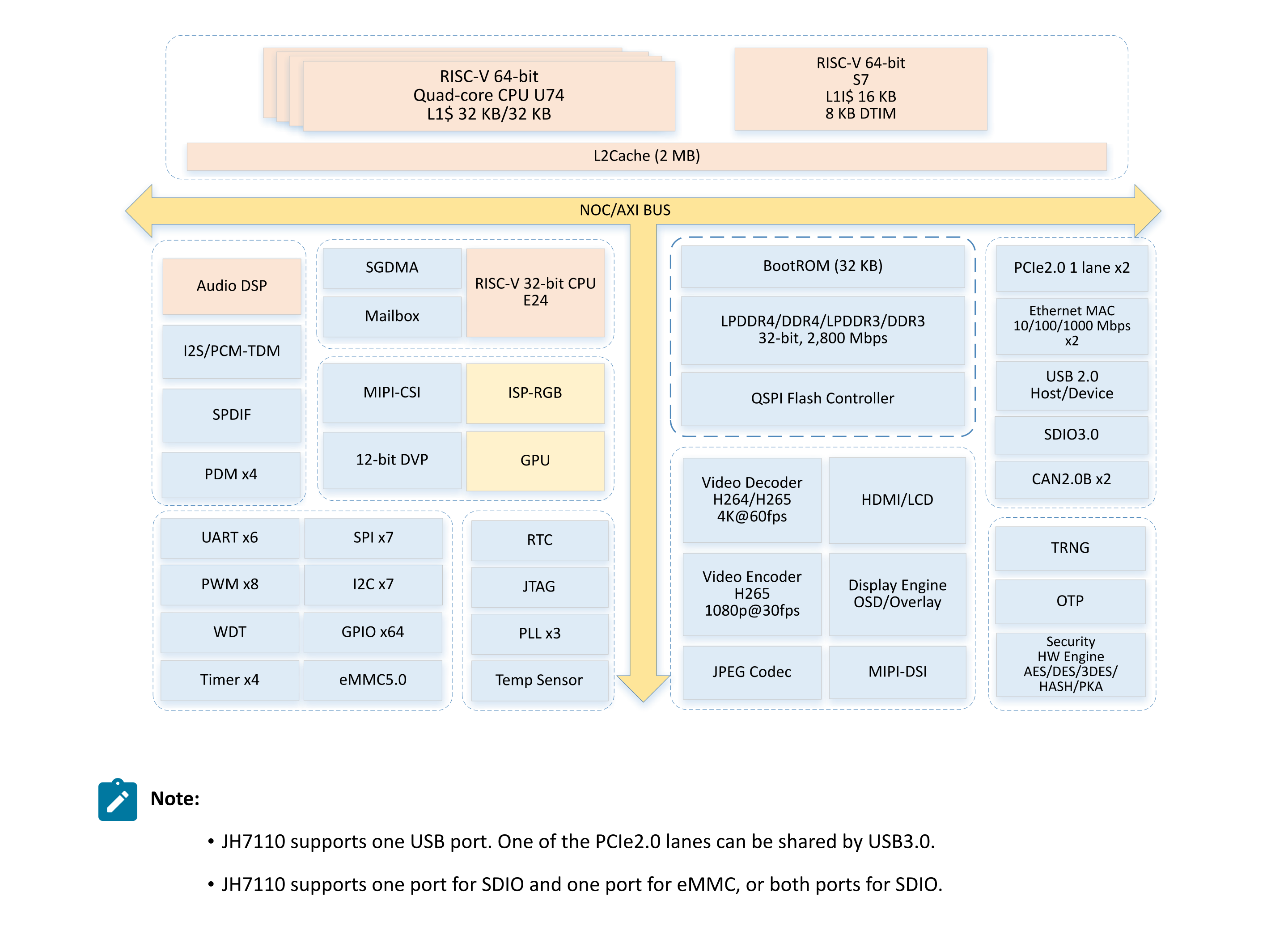STAR64
Revision as of 20:49, 8 May 2023 by Tllim (talk | contribs) (→Board Information, Schematics and Certifications)
The Star64 is a RISC-V based Single Board Computer powered by StarFive JH7110 Quad-Core SiFive U74 64-Bit CPU, Imagination Technology BX-4-32 GPU and supports up to 8GB 1866MHz LPDDR4 memory. It provides an eMMC module socket, MicroSD Card slot, PCI-e, Pi-2 Bus, USB 3.0, and many other peripheral interfaces for makers to integrate with sensors and other devices.
Software releases
The releases are still in alpha state and are only fit for testing purposes.
SoC and Memory Specification
- Based on StarFive JH7110
CPU Architecture
- Fully compliant with the RISC-V ISA specification
- 64-bit RISC-V Application Core
- 32KB L1 I-cache with ECC
- 32KB L1 D-cache with ECC
- 8 Region Physical Memory Protection
- Virtual Memory support with up to 47 Physical Address bits
- Integrated up to 2MB L2 Cache with ECC
- includes RV64IMAC S7 monitor core, 16 KB L1 I-Cache with ECC, 8 KB DTIM with ECC
- 32-bit RISC-V CPU core (E24) for real time control, support RV32IMFC RISC-V ISA
GPU Architecture
- Support OpenCL 3.0
- Support OpenGL ES 3.2
- Support Vulkan 1.2
- Tile-based deferred rendering architecture for 3D graphics workloads, with concurrent processing of multiple tiles
- Support for GPU visualization, up to 8 virtual GPUs
- On fly frame buffer compression and decompression (TFBC) algorithm
- Performance: 128 FP32 FLOPs/Clock, 256 FP16 FLOPs/Clock
System Memory
- LPDDR4 RAM Memory Variants: 2GB, 4GB and 8GB.
Board Features
Video
- Digital Video output up to 4K@30Hz
- 4K HDR @ 60fps
- H.264/AVC Base/Main/High/High10 profile @ level 5.1; up to 4K×2K @ 60fps
- H.265/HEVC Main/Main10 profile @ level 5.1 High-tier; up to 4K×2K @ 60fps
Audio
- 3.5mm audio Jack
Network
- Single or Dual 10/100/1000Mbps Ethernet
- 2.4GHz/5Ghz MIMO WiFi 802.11 b/g/n/ac with Bluetooth 5.2
Storage
- on-board 128Mbit (16MByte) XSPI NOR flash memory - bootable
- microSD - bootable, supports SDHC and SDXC and storage up to 256GB
- eMMC - bootable (optional eMMC Module)
- 1× USB3.0 Dedicated Host port
- 3× USB2.0 Host port
Expansion Ports
- PCIe 2.0 ×1 lane
- 2×20 pins "Pi2" GPIO Header
- The JH7110 SoC supports full multiplexing of its GPIO pins. This means any non-power/ground pin can be configured to any function outlined in Table 4-2 of the SoC datasheet.
- 4 lane MiPi DSI port for LCD panel
- 4 lane MiPi CSI port for camera module
Board Information, Schematics and Certifications
- Model "A" Baseboard Dimensions: 133mm×80mm×19mm
- Input Power: DC 12V @ 3A 5.5mmOD/2.1mmID center-positive Barrel DC Jack connector
- Schematic:
- Certifications:
- Disclaimer: Please note that PINE64 SBC is not a "final" product and in general certification is not necessary. However, PINE64 still submits the SBC for FCC, CE, and ROHS certifications and obtain the certificates to prove that the SBC board can pass the testing. Please note, a final commercial product needs to perform its own testing and obtain its own certificate.
- Not yet available
Datasheets for Components and Peripherals
- Star64 JH7110 SoC information:
- X-Power PMU information:
- LPDDR4 (200 Balls) SDRAM:
- eMMC information:
- SPI NOR Flash information:
- Ethernet related info:
- TBA
- WiFi/BT module info:
Bringup Notes
- The USB over-current protection is not wired up correctly to the USB ports on Star64. The default Starfive Kernel will disable USB on boot as it belives the ports are overcurrent. This ugly hack works around it: https://github.com/Fishwaldo/Star64_linux/commit/2634a13ecfa1fa5c232ec2b9f6a6b6b0d9d66898
- The Wifi Chip (RTL8852BU) is not supported in the kernel. There is a Vendor Driver that is imported in the kernel at https://github.com/Fishwaldo/Star64_linux/tree/Star64_devel/drivers/staging/rtl8852bu but it really needs a cleanup. It does BUG_ON at boot, but wifi is confirmed working.
- HDMI can be finicky. 4K Monitors are known to have a issue. This is also relevant for VisionFive2
- Some kernels/distributions do not detect the total memory correctly. This is due to the way u-boot is configured. Currently, u-boot reads the memory from the eeprom on the Star64, and updates the dtb file before booting the kernel. Distributions that boot differently may not get the updated dtb file with the correct memory entry. You can work around this by recompiling the DTB with the correct memory for your board
- VisionFive2 Kernels will only offer limited functionality on the Star64 - Mainly USB, Wifi and PCI will not work.
Prototype Bringup Notes
Note: This section is relevant to the original prototype (v1.0) that a few developers received.
- The schematic has several discrepancies with actual board labels.
- The serial console can be found with TXD on pin 8 and RXD on pin 10; a convention common to Pi-style boards. Use the 40pin header pinouts in color on page one and not the schematic prose.
- If you have only a single core running and no PCI card present, it appears to power up via the +5V/GND lines from the USB serial adapter pins.
- It will not boot from a VisionFive R1 uSD card.
- The boot device switch labels and the silk screen are inverted. "0" means "On".
- 2021.10-00001-gdbdaad919b will attempt to boot from SPI, but it appears blank. If you let it for many minutes, the device will eventually time out and boot OpenSBI v1.0 from (SPI?). This will fail, but only after self-identifying as a VisionFive R2, complete with five cores and 4 GB of RAM, before failing. A "press any key" timeout is offered, but I've been unable to make it stop. It will eventually crash with:
Loading Environment from SPIFlash... SF: Detected gd25lq128 with page size 256 Bytes, erase size 4 KiB, total 16 MiB *** Warning - bad CRC, using default environment Not a StarFive EEPROM data format - magic error





